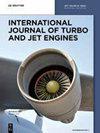体积效应对跨声速压气机瞬态特性的影响
IF 0.9
4区 工程技术
Q4 ENGINEERING, AEROSPACE
引用次数: 0
摘要
摘要尽管体积效应在压缩机流动不稳定性中具有重要意义,但在加速和减速过程中体积效应对压缩机性能的重要性却受到了有限的关注。为了更好地理解这种影响,使用内部模拟程序CAM(模块化瞬态模拟器)来研究体积对压缩机瞬态性能的影响。根据Greziter的集总参数方法推导了建模过程,并通过实验数据验证了仿真模型的准确性。本研究对不同条件下观察到的压缩机瞬态行为的变化进行了全面的比较和解释,包括不同的轴转速变化率、压缩机体积大小和运行速度。压缩机入口和出口质量流量之间的相对差异被认为是造成这些差异的关键因素。此外,还开发了一个简化的分析模型,以提供加速和减速期间压缩机运行线的基本描述,这也为数值结果的有效性提供了额外的支持。本研究系统地建立了轴转速变化、压力和质量流量变化之间的动态相关性,为确保压缩机在瞬态运行期间的安全提供了关键信息。本文章由计算机程序翻译,如有差异,请以英文原文为准。
The role of volume effect on the transient behavior of a transonic compressor
Abstract The significance of the volume effect on the compressor performance during acceleration and deceleration has received limited attention, despite its demonstrated importance in compressor flow instabilities. To better understand this effect, the in-house simulation program CAM (a modular transient simulator) is used to investigate the volume effect on the compressor transient performance. The modeling procedure is derived from Greziter’s lumped parameter approach and the accuracy of the simulation model is verified by experimental data. This study presents a comprehensive comparison and explanation of variations in compressor transient behavior observed under different conditions, including different shaft speed change rates, compressor volume sizes, and operating speeds. The relative difference between the compressor inlet and outlet mass flow is identified as the key factor contributing to these discrepancies. In addition, a simplified analytical model is developed to provide a basic description of the compressor operating line during acceleration and deceleration, which also provides additional support for the validity of the numerical results. This study systematically establishes the dynamic dependencies between shaft speed change, pressure and mass flow change, offering critical information for ensuring the safety of compressors during transient operation.
求助全文
通过发布文献求助,成功后即可免费获取论文全文。
去求助
来源期刊

International Journal of Turbo & Jet-Engines
工程技术-工程:宇航
CiteScore
1.90
自引率
11.10%
发文量
36
审稿时长
6 months
期刊介绍:
The Main aim and scope of this Journal is to help improve each separate components R&D and superimpose separated results to get integrated systems by striving to reach the overall advanced design and benefits by integrating: (a) Physics, Aero, and Stealth Thermodynamics in simulations by flying unmanned or manned prototypes supported by integrated Computer Simulations based on: (b) Component R&D of: (i) Turbo and Jet-Engines, (ii) Airframe, (iii) Helmet-Aiming-Systems and Ammunition based on: (c) Anticipated New Programs Missions based on (d) IMPROVED RELIABILITY, DURABILITY, ECONOMICS, TACTICS, STRATEGIES and EDUCATION in both the civil and military domains of Turbo and Jet Engines.
The International Journal of Turbo & Jet Engines is devoted to cutting edge research in theory and design of propagation of jet aircraft. It serves as an international publication organ for new ideas, insights and results from industry and academic research on thermodynamics, combustion, behavior of related materials at high temperatures, turbine and engine design, thrust vectoring and flight control as well as energy and environmental issues.
 求助内容:
求助内容: 应助结果提醒方式:
应助结果提醒方式:


